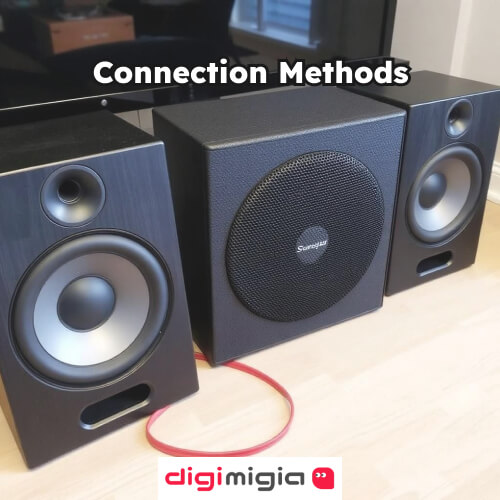How to Connect Subwoofer to Speakers? how to connect speakers to a subwoofer?

Whether you’re into music, movies, or video games, adding a subwoofer to your amplifier and speakers can really improve your audio experience. A subwoofer adds deep, powerful bass that gives your sound more depth and richness, making every beat, explosion, and low rumble feel more intense. But if you’re wondering how to connect the subwoofer to speakers, don’t worry—it’s not as complicated as it might seem. In most cases, all you need is a subwoofer cable to link the two devices together. In this full guide on Digimigia, we’ll show you how to easily add a subwoofer to your home sound system. We’ll go over all the parts you need, how to pick the best way to connect it, and how to adjust everything for the best sound possible.
Connection Methods
How to connect the subwoofer to speakers? Here are three different subwoofer connection types to your speakers. We have listed them from the best option to the least recommended.

LFE/Subwoofer Output
This is a single cable that connects the SUB OUT from your device to the input on your active subwoofer. Your active speakers or amplifier will have a special output, usually an RCA port labeled “SUB OUT” or something like that. You should use a specific subwoofer cable to connect them. You might see that your subwoofer has two input ports, red and white, but your speakers or amplifier only have one RCA output. Just plug the single cable into the white port. It might be labeled “LFE” on the subwoofer. In order to make the connection, perform the following steps:
- Take one end of the subwoofer cable and plug it into the SUB OUT port on your speakers or amplifier.
- Take the other end of the subwoofer cable and connect it to the LFE input on your subwoofer.
- If there is no port labeled LFE, use the white port of the RCA input instead.
Stereo RCA Connections
This is an RCA or 3.5mm connection between your speakers or amplifier and your subwoofer. Your active speakers or amplifier will have an output labeled “LINE OUT,” or sometimes it might still be called “SUB OUT.” This is a stereo output, so you can connect it to a subwoofer using a stereo audio cable. Keep in mind that since this is a stereo line output, your subwoofer needs to have a built-in crossover. But don’t worry, most subwoofers come with one already. To make the connection, you should follow the next steps:
- Plug one end of the RCA or 3.5mm cable into the line output, which might be labeled as “sub out,” on your active speakers or amplifier.
- Then, connect the other end of the RCA cable to the RCA input on your subwoofer.

Speaker-level (high-level) Inputs
How to connect subwoofer to speakers without sub out? This is not very common, but if your amplifier doesn’t have a subwoofer output, you can use a speaker level subwoofer instead. This kind of subwoofer is rare, but it can technically connect to any amplifier. The subwoofer has speaker inputs, which are usually the red and black terminals with springs. Keep in mind that this method won’t work with active speakers. To make the connection via this method, follow the next steps:
- Plug the amplifier’s speaker output into the left and right high-level speaker inputs on the subwoofer.
- Then, connect your speakers to the left and right speaker terminals on the subwoofer.
Setting Up Your System
Once you’ve connected the subwoofer, it’s important to set it up correctly to get the best sound quality. Here’s how to adjust the settings for the best bass performance.
Choosing and Connecting cables
For most home theater setups, using one RCA cable is the best way to connect to the LFE (Low-Frequency Effects) or subwoofer output on your receiver. If your subwoofer only has speaker-level inputs and your receiver doesn’t have an RCA output for the subwoofer, then you should use speaker wire instead. To get a better connection and send the signal more clearly, pick a high-quality cable made of copper or copper that’s been coated with silver. Connecting subwoofer to the speaker via RCA is the best method; however, if there was no RCA output, speaker level input can be the best connecting cables.
Placement Considerations
Move slowly around the room and listen for the spot where the bass sounds smooth and balanced; that’s where the subwoofer should go. You might also try putting it in a front corner for stronger bass or in the center front for better sound blending and less noticeable bass.

Configuring Settings
For configuring settings, you should check volume and crossover. You should begin with the volume that is on a low level and slowly raise it. Once all the devices are connected and turned on, you can slowly raise the volume to get the right sound level that works well with your active speakers. You should also set the crossover frequency on the subwoofer. A good starting point of the crossover is about 80Hz, but you might need to change it that is depending on how well your main speakers can handle low sounds. The idea is for the subwoofer to take care of the deep bass and let your main speakers handle all the higher sounds.
Conclusion
Connecting a subwoofer to your active speakers can really boost your audio listening experience by adding more depth and richness to your sound quality of your speaker. By following the step-by-step guide in this study on Digimigia that tells you how to connect subwoofer to speakers, you can make the connection smooth and work well. So, you can enjoy better bass and overall sound quality. Whether you love music, movies, or gaming, setting it up right can really change how you experience sound.

